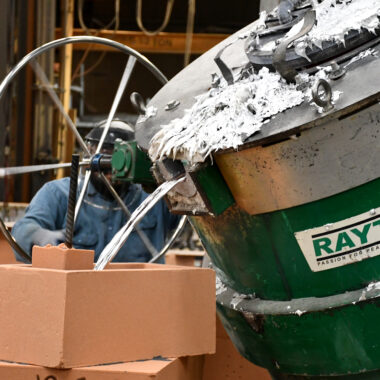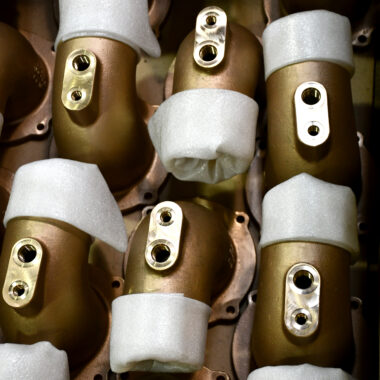Opening Success: Casting Aluminum Made Easy
Opening Success: Casting Aluminum Made Easy
Blog Article
Unlocking the Prospective of Light Weight Aluminum Casting: A Comprehensive Overview
Light weight aluminum casting stands as a foundation in the world of metalworking, using a wide variety of benefits and applications throughout different markets. From its historic importance to the modern-day developments in casting techniques, light weight aluminum has actually constantly proven itself as a functional and valuable product. As we browse via the landscape of aluminum casting procedures and look into the details of quality assurance steps, an extensive summary of opening truth possibility of this steel arises. The possibilities appear limitless, appealing understandings that could transform the means we make use of and view light weight aluminum in manufacturing (casting aluminum).

History of Light Weight Aluminum Casting
Aluminum spreading has an abundant historic background that goes back to ancient civilizations, showcasing the sustaining relevance of this metallurgical process in various sectors. The roots of aluminum casting can be traced to around 5,000 B.C. when ancient worlds like the Egyptians and the Sumerians utilized fundamental methods to cast tiny items. It was not till the 19th century that light weight aluminum casting saw substantial developments with the exploration of the Hall-Héroult process for drawing out light weight aluminum from its ore, making it a lot more accessible for casting functions.
The flexibility of aluminum casting enabled for complex styles and complicated shapes to be produced with precision, even more fueling its adoption throughout various markets. Today, light weight aluminum casting continues to be a foundation in the production of a large variety of products, highlighting its long-lasting tradition and value in modern-day production processes.
Applications and benefits
With its extraordinary strength-to-weight ratio and excellent thermal conductivity, aluminum casting uses a myriad of advantages and varied applications across various markets. One of the key advantages of light weight aluminum casting is its light-weight nature, making it an ideal selection for industries where weight decrease is important, such as automotive and aerospace. casting aluminum. Furthermore, aluminum casting offers excellent rust resistance, ensuring longevity and longevity in extreme environments. Its high thermal conductivity likewise makes it a recommended choice for applications calling for warm dissipation, like in digital elements and warmth exchangers.
In terms of applications, light weight aluminum spreading is extensively utilized in the automobile market for parts like engine blocks, cyndrical tube heads, and wheels due to its strength and lightweight properties. The construction market gain from light weight aluminum spreading in the production of architectural parts and attractive components. The versatility of light weight aluminum spreading prolongs to consumer electronics, where it is used in the production of casings and warmth sinks. Generally, the advantages of aluminum casting combined with its varied applications make it a crucial product in numerous commercial fields.
Kinds Of Aluminum Casting Procedures

Among the various techniques employed in commercial settings, aluminum spreading procedures encompass a variety of techniques suited to different applications and requirements. Financial investment casting, additionally understood as lost-wax spreading, is favored for its capacity to produce complex and comprehensive components with a smooth surface finish. Each of these light weight aluminum casting processes supplies one-of-a-kind advantages, providing to a vast range of commercial demands.
Advancements in Light Weight Aluminum Casting Strategies
Recent improvements in aluminum casting methods have actually transformed the production sector, using improved efficiency and precision in the manufacturing of facility components. One noteworthy advancement is the growth of 3D sand printing innovation, which makes it possible for the development of detailed sand mold and mildews with minimal manual work. This method enables higher style versatility and faster manufacturing cycles, making it excellent for prototyping and small batch production.
Furthermore, using sophisticated simulation software has substantially improved the spreading process by allowing engineers to enhance mold styles and forecast potential issues prior to manufacturing starts (casting aluminum). This leads to enhanced product high quality and lowered product waste
In addition, the fostering of vacuum-assisted aluminum casting has improved the total top quality of spreadings by minimizing porosity and ensuring an extra consistent circulation of molten metal. This strategy is specifically helpful for components that call for high architectural stability and exceptional surface coating.
Quality Assurance in Aluminum Spreading
The improvements in light weight aluminum spreading methods have not only boosted effectiveness and precision browse around here yet have also underscored the essential significance of quality assurance in ensuring the dependability and performance of cast parts. Quality control in light weight aluminum casting entails a methodical approach to assess the manufacturing and keep an eye on process, determining any variances from established criteria that might impact the final product.
One crucial facet of quality control is the usage of advanced innovations such as non-destructive screening methods like X-ray and ultrasound to identify internal flaws without compromising the stability of the actors parts. Furthermore, implementing strenuous evaluation methods at various stages of manufacturing helps in determining and remedying issues quickly, guaranteeing that only elements meeting the specified requirements are launched for usage.
Furthermore, high quality control navigate here prolongs past the manufacturing process to include post-casting treatments like warmth therapy and surface area finishing, guaranteeing that the end products meet the desired specs. By prioritizing quality assurance actions, manufacturers can enhance product consistency, toughness, and total consumer complete satisfaction in the realm of aluminum casting.
Final Thought
Finally, aluminum casting has a rich history and provides various advantages and applications across various industries. Different kinds of casting procedures and ingenious methods have been established to enhance the efficiency and quality of aluminum spreading. Quality assurance measures play an essential role in guaranteeing the final items fulfill the needed requirements. Overall, aluminum spreading proceeds to be a useful manufacturing procedure with wonderful possible for additional developments in the future.
As we browse with the landscape of aluminum spreading processes and dive into the details of high quality control procedures, a comprehensive introduction of opening the true potential of this metal emerges. It was not up until the 19th century that aluminum spreading saw significant improvements with the discovery of the Hall-Héroult procedure for extracting light weight aluminum from its ore, making it more easily accessible for casting purposes.
Amongst the various techniques used in industrial setups, check this aluminum casting procedures encompass a range of methods matched to different applications and needs. Investment casting, likewise recognized as lost-wax casting, is preferred for its capability to generate elaborate and in-depth components with a smooth surface area finish. Different types of casting processes and ingenious strategies have actually been developed to improve the effectiveness and top quality of aluminum casting.
Report this page